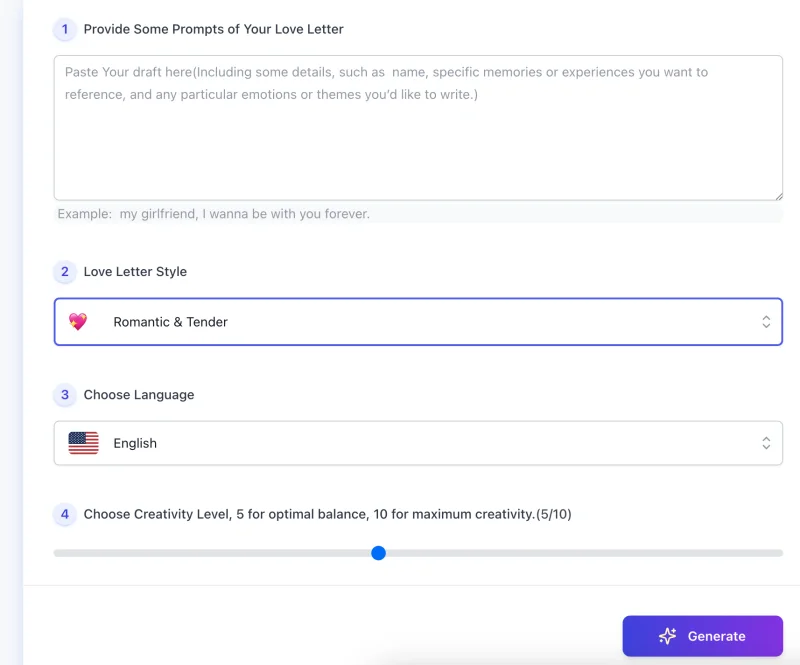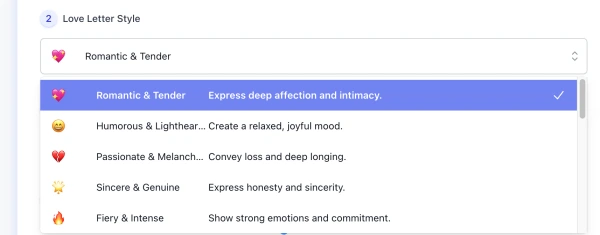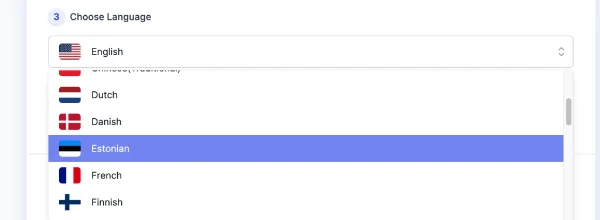Free AI Tools. No Sign-Up Required. Full Access.
AI Love Letter Generator
Struggling to find the right words? Our Free AI Love Letter Generator helps you turn deep emotions into touching messages instantly. Whether it’s a romantic confession, a heartfelt apology, or wedding vows, create the perfect letter for Him or Her in seconds. 100% Private & No Sign-up required.
Combine the current tool with these other tools to work more efficiently.
Discover other tools with functions and purposes similar to the one you are currently viewing.
- AI Love Poem Generator

- AI Letter Writer Generator

- AI Write Message Generator
- AI Greeting Card Writer

- AI Flirty Text Messages Generator

- AI Thank You Note Generator

- AI Christmas Messages Generator

- AI Thank You Messages Generator

- AI Text Generator

- AI Poem Generator
- AI Letter of Recommendation Generator

- AI Happy Birthday Message Generator

Discover the tools most favored and highly-rated by users on our website.
Explore more AI tools in these related categories
AI Writing tools generate, or enhance text content for various writing tasks.
AI tools that automatically create text content for your images, audio, or video from user prompts.
AI tools that assist with daily routines, personal organization, and lifestyle management tasks.
Welcome to the AIFreeBox AI Love Letter Generator—a free style-driven assistant designed to help you express love with clarity and sincerity. Whether you are struggling to write a heartfelt apology, a romantic anniversary note, or a first confession, our tool helps you overcome writer’s block in seconds. We believe this is a sincere tool for building real human connection—not just a machine for manufacturing emotion.
On this page, you’ll find what the tool does, how to use it, supported styles, writing tips, known limitations, common issues, and FAQs. Everything here is built to help you write love letters that feel honest, personal, and truly your own.
What Can AIFreeBox AI Love Letter Generator Do?
The AIFreeBox AI Love Letter Generator wasn’t built to impress with fancy words—it was made to help you say what you truly feel. With nearly 20 built-in styles and support for 33 languages, it helps you match the tone of your message to the moment—whether it’s playful, romantic, nostalgic, or sincere. Each letter is shaped by a custom language model designed to support—not replace—your voice. The goal is simple: to help you find the right words for real emotions, and express love in a way that feels honest, not artificial.
Recommend Use Cases & Who It’s For
| Use Case | Who It’s For | How It Helps |
|---|---|---|
| Confessing your feelings | For someone new you’re falling for | Helps you find the right words to express love sincerely and clearly. |
| Anniversaries & special dates | For partners and spouses | Generates personalized letters that match the tone of the moment. |
| Long-distance relationships | For couples apart by distance | Supports emotional expression when words are hard to find. |
| Rekindling connection | For relationships that feel distant or quiet | Provides thoughtful prompts to help restart honest conversation. |
| Everyday reminders of love | For anyone you care about deeply | Creates warm, genuine messages to stay emotionally close. |
How to Write a Love Letter with AIFreeBox AI:
Step-by-Step Guide

Follow these steps to write a love letter that feels personal, thoughtful, and true to your emotions:
1. Provide Some Prompts
Describe what you’d like to express—such as the recipient’s name, shared memories, or the emotions you want to convey. The more personal the details, the more authentic the letter will feel.
2. Select a Love Letter Style

Choose from nearly 20 styles to match the tone of your message—whether it’s romantic, sincere, playful, poetic, or nostalgic.
3. Choose Language

Pick from 33 supported languages so your letter can be written in the language that best connects with your reader.
4. Set Creativity Level
Use the slider to adjust creativity: level 5 for balance, or higher levels for more expressive and emotionally rich letters.
5. Click “Generate”
The tool will create a letter draft based on your input—ready for you to personalize, refine, or send as it is.
6. Report Bug or Feedback (Real Human Support)

If you encounter issues, use the Report Bug button. A support team member will review your feedback promptly—your experience is taken seriously, and real people are ready to help.
This tool is here to support your voice—not replace it. Use it to say what matters, in a way that truly feels like you.
Tips for Better Love Letters
To make your letter feel more personal and meaningful, keep these tips in mind:
- Be specific in your prompts
Mention names, memories, or small details—things only the two of you share. The tool responds better to real context. - Choose a style that matches your intent
Think about what you want the letter to feel like—warm, playful, apologetic—and pick a tone that supports that. - Write as if you’re speaking to them
Use natural language in your prompts. Imagine you’re saying it out loud—that helps keep the tone authentic. - Let the AI draft, then make it yours
Use the generated letter as a starting point. Add a personal touch, adjust a sentence, or end it in your own voice.
Examples: What Works Better
Here are some examples to show the difference between vague prompts and specific, emotionally grounded ones:
| Not So Good | Much Better |
|---|---|
| “Write a romantic letter to my girlfriend.” | “Write a romantic letter to my girlfriend Lily—we’ve just moved in together and I want to tell her how happy that makes me.” |
| “Say something nice to my partner.” | “Tell my partner James how proud I am of him for finishing his first marathon last weekend.” |
| “I miss her.” | “Tell her I miss waking up next to her, especially on Sunday mornings when we used to make pancakes together.” |
| “Make it poetic.” | “Make it poetic—use nature imagery, like the ocean or moonlight, to describe how calm I feel when I’m with her.” |
| “Use the playful style.” | “Use the playful style—mention how she always steals the blanket and how I pretend to be annoyed but secretly love it.” |
Pick Your Love Letter Style
Choose a tone that fits your moment. Works in all 33 languages.
- 💖 Romantic — Soft, heartfelt affection.
- 🌟 Sincere — Honest, straightforward tone.
- 🌅 Hopeful — Gentle reassurance and optimism.
- 🫂 Apologetic — Own mistakes; rebuild trust.
- 🍂 Missing You — Tender longing and memories.
- 📝 Poetic — Lyrical phrasing and imagery.
- 🔮 Reflective — Thoughtful meaning and depth.
- 💔 Bittersweet — Soft ache, distance, or loss.
- 🔥 Passionate — High emotion and intensity.
- ⚓ Devoted — Steady promise and commitment.
- 😄 Funny — Light, playful humor.
- 😏 Flirty — Teasing banter and spark.
- 🤓 Nerdy — Shared fandoms and clever nods.
- 🍭 Sweet — Pure, gentle affection.
- 🌈 Joyful — Bright, happy energy.
- 🏛️ Classic — Traditional, timeless tone.
- 📱 Modern — Simple, conversational language.
- 🌙 Mysterious — Subtle allure, restrained pull.
- 🪞 Honest — Plainspoken truth, no fluff.
- 🧩 Supportive — Kind encouragement and care.
Tool Limitations & What to Expect
| Limitation | Why It Happens | What You Should Know |
|---|---|---|
| Not emotionally aware like a human | AI doesn’t truly “feel” emotions—it interprets patterns in language | The letter may sound sincere, but it’s still your input that gives it meaning. Use personal details to guide it. |
| Struggles with subtle tone shifts | Nuances like bittersweet, restrained affection, or layered humor are hard for models to balance | If the tone feels off, try simplifying your emotional intent or adjusting the style selection. |
| May occasionally repeat ideas or phrases | The model prioritizes coherence, which can lead to redundancy | You may need to lightly edit the output to remove repeated lines or tighten flow. |
| Limited cultural or language nuance in some cases | Performance can vary across the 33 supported languages | Some phrases may feel translated. If it reads oddly, try rephrasing your prompt or switch to a language you’re fluent in. |
| Cannot invent shared history | The model relies entirely on the input it receives | It won’t “know” your story—you need to provide it. The more context you give, the more personal the letter feels. |
These limitations don’t mean the tool isn’t useful—they simply remind us what it’s for. You’re still the one writing the letter. The AI helps shape the words, but the intent, the memory, the meaning—that still comes from you.
FAQs
Do I need an account to use this tool?
No, you can use the tool freely without creating an account. Everything runs directly in your browser.
Will the AI remember my past letters or data?
No, it doesn’t store any personal data or history. Each session is private and independent.
Can this tool really replace how I would write a letter myself?
No—it’s not meant to replace you. It helps you find the words for a love letter, a thank you note, or any message where your own feelings matter most.
What if the letter doesn’t sound quite right?
Use it as a starting point. You can regenerate, try a different style, or edit the output until it sounds more like you.
Is it okay to write in another language?
Yes. The tool supports 33 languages. Choose the one you feel most comfortable expressing love in—or the one your recipient prefers.
Can it write for complex situations like apologies or long-distance relationships?
Yes. You can use detailed prompts to describe your situation, and choose a matching style like “Apologetic & Healing” or “Hopeful & Reassuring.”
Will the letter sound too much like AI?
If your prompt is too vague, it might. Try adding specific moments, names, or emotions—that’s what makes the difference.
Creator’s Note
Love isn’t always easy to put into words. That’s why I built this tool—not to write for you, but to help you say what you already feel.
The AI behind this tool doesn’t know your story. It doesn’t know what you’ve been through, or how much that one message might matter. What it can do is offer structure, tone, and rhythm—so that when you sit down to write, you’re not starting from a blank page.
At its core, this tool is about collaboration. You bring the meaning; it helps shape the words. If it sounds like you when you read it back, then it’s working.
— Matt Liu
2025-10-20
💌 Ready to share your heart? Install the Free AI Love Letter Generator for Chrome
Express love with clarity and sincerity — let AI help you find the words that truly matter.